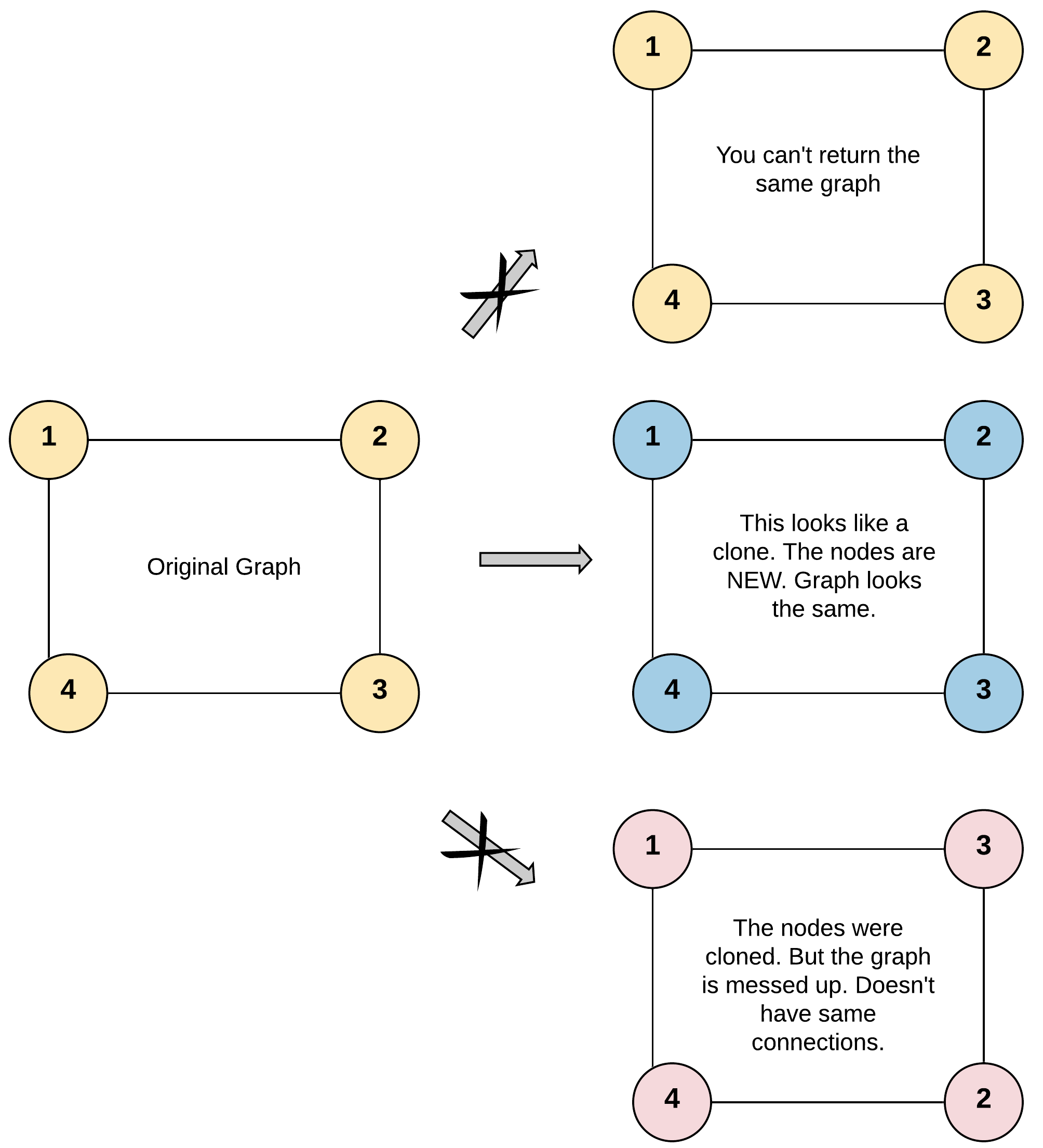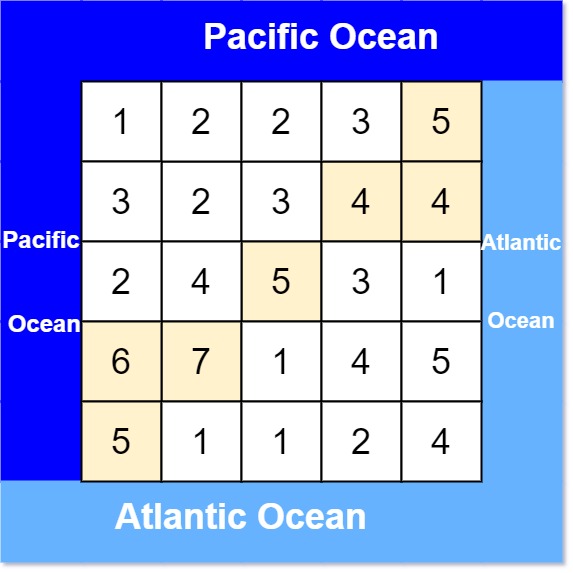Graphs
Depth First Search
Breadth First Search
Problems
Question 1. Number of Islands
Medium
Solution
Given an m x n 2D binary grid grid which represents a map of '1's (land) and '0's (water), return the number of islands.
An island is surrounded by water and is formed by connecting adjacent lands horizontally or vertically. You may assume all four edges of the grid are all surrounded by water.
Example 1:
Input: grid = [
["1","1","1","1","0"],
["1","1","0","1","0"],
["1","1","0","0","0"],
["0","0","0","0","0"]
]
Output: 1
Example 2:
Input: grid = [
["1","1","0","0","0"],
["1","1","0","0","0"],
["0","0","1","0","0"],
["0","0","0","1","1"]
]
Output: 3
def num_islands(grid):
pass
assert num_islands([
["1","1","1","1","0"],
["1","1","0","1","0"],
["1","1","0","0","0"],
["0","0","0","0","0"]
]) == 1, "Test case 1 failed"
assert num_islands([
["1","1","0","0","0"],
["1","1","0","0","0"],
["0","0","1","0","0"],
["0","0","0","1","1"]
]) == 3, "Test case 2 failed"
assert num_islands([
["1","1","1"],
["0","1","0"],
["1","1","1"]
]) == 1, "Test case 3 failed"
Question 2. Clone Graph
Medium
Solution
Given a reference of a node in a connected undirected graph.
Return a deep copy (clone) of the graph.
Each node in the graph contains a value (int) and a list (List[Node]) of its neighbors.
Test Case Format:
For simplicity, each node’s value is the same as the node’s index (1-indexed). For example, the first node with val == 1, the second node with val == 2, and so on. The graph is represented in the test case using an adjacency list.
An adjacency list is a collection of unordered lists used to represent a finite graph. Each list describes the set of neighbors of a node in the graph.
The given node will always be the first node with val = 1. You must return the copy of the given node as a reference to the cloned graph.
Example 1:

Input: adjList = [[2,4],[1,3],[2,4],[1,3]]
Output: [[2,4],[1,3],[2,4],[1,3]]
Explanation: There are 4 nodes in the graph.
1st node (val = 1)’s neighbors are 2nd node (val = 2) and 4th node (val = 4).
2nd node (val = 2)’s neighbors are 1st node (val = 1) and 3rd node (val = 3).
3rd node (val = 3)’s neighbors are 2nd node (val = 2) and 4th node (val = 4).
4th node (val = 4)’s neighbors are 1st node (val = 1) and 3rd node (val = 3).
class Node:
def __init__(self, val = 0, neighbors = None):
self.val = val
self.neighbors = neighbors if neighbors is not None else []
def clone_graph(node):
pass
assert clone_graph([[2,4],[1,3],[2,4],[1,3]]) == [[2,4],[1,3],[2,4],[1,3]], "Test case 1 failed"
assert clone_graph([[2,3],[1,3],[1,2]]) == [[2,3],[1,3],[1,2]], "Test case 2 failed"
assert clone_graph([[2],[1]]) == [[2],[1]], "Test case 3 failed"
print("Test cases passed :)")
Question 3. Pacific Atlantic Water Flow
Medium
Solution
There is an m x n rectangular island that borders both the Pacific Ocean and Atlantic Ocean. The Pacific Ocean touches the island’s left and top edges, and the Atlantic Ocean touches the island’s right and bottom edges.
The island is partitioned into a grid of square cells. You are given an m x n integer matrix heights where heights[r][c] represents the height above sea level of the cell at (r, c).
The island receives a lot of rain, and the rain water can flow to neighboring cells directly north, south, east, and west if the neighboring cell’s height is less than or equal to the current cell’s height. Water can flow from any cell adjacent to an ocean into the ocean.
Return a list of grid coordinates result where result[i] = [ri, ci] denotes that rain water can flow from cell (ri, ci) to both the Pacific and Atlantic oceans.
Example 1:
Input: heights = [[1,2,2,3,5],[3,2,3,4,4],[2,4,5,3,1],[6,7,1,4,5],[5,1,1,2,4]]
Output: [[0,4],[1,3],[1,4],[2,2],[3,0],[3,1],[4,0]]
Explanation: The following cells can flow to the Pacific and Atlantic oceans, as shown below:
[0,4]: [0,4] -> Pacific Ocean
[0,4] -> Atlantic Ocean
[1,3]: [1,3] -> [0,3] -> Pacific Ocean
[1,3] -> [1,4] -> Atlantic Ocean
[1,4]: [1,4] -> [1,3] -> [0,3] -> Pacific Ocean
[1,4] -> Atlantic Ocean
[2,2]: [2,2] -> [1,2] -> [0,2] -> Pacific Ocean
[2,2] -> [2,3] -> [2,4] -> Atlantic Ocean
[3,0]: [3,0] -> Pacific Ocean
[3,0] -> [4,0] -> Atlantic Ocean
[3,1]: [3,1] -> [3,0] -> Pacific Ocean
[3,1] -> [4,1] -> Atlantic Ocean
[4,0]: [4,0] -> Pacific Ocean
[4,0] -> Atlantic Ocean
Note that there are other possible paths for these cells to flow to the Pacific and Atlantic oceans.

def pacific_atlantic(heights):
pass
assert pacific_atlantic([
[1,2,2,3,5],
[3,2,3,4,4],
[2,4,5,3,1],
[6,7,1,4,5],
[5,1,1,2,4]
]) == [[0,4],[1,3],[1,4],[2,2],[3,0],[3,1],[4,0]], "Test case 1 failed"
assert pacific_atlantic([
[1,2,3],
[8,9,4],
[7,6,5]
]) == [[0,2],[1,0],[1,1],[1,2],[2,0],[2,1],[2,2]], "Test case 2 failed"
assert pacific_atlantic([
[2,1],
[1,2]
]) == [[0,0],[0,1],[1,0],[1,1]], "Test case 3 failed"
print("Test cases passed :)")
Question 4. Course Schedule
Medium
Solution
There are a total of numCourses courses you have to take, labeled from 0 to numCourses - 1. You are given an array prerequisites where prerequisites[i] = [ai, bi] indicates that you must take course bi first if you want to take course ai.
For example, the pair [0, 1], indicates that to take course 0 you have to first take course 1.
Return true if you can finish all courses. Otherwise, return false.
Example 1:
Input: numCourses = 2, prerequisites = [[1,0]] Output: true
Explanation: There are a total of 2 courses to take. To take course 1 you should have finished course 0. So it is possible.
Example 2:
Input: numCourses = 2, prerequisites = [[1,0],[0,1]] Output: false
Explanation: There are a total of 2 courses to take. To take course 1 you should have finished course 0, and to take course 0 you should also have finished course 1. So it is impossible.
def can_finish(numCourses, prerequisites):
pass
assert can_finish(2, [[1,0]]) == True, "Test case 1 failed"
assert can_finish(2, [[1,0],[0,1]]) == False, "Test case 2 failed"
assert can_finish(4, [[1,0],[2,0],[3,1],[3,2]]) == True, "Test case 3 failed"
print("Test cases passed :)")